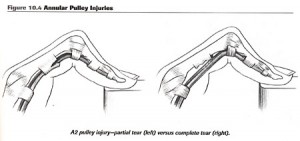Snap, Crackle, Pop – Now What?
 This is the first in an ongoing series of articles that will take a look at climbing injuries and how to deal with them.
This is the first in an ongoing series of articles that will take a look at climbing injuries and how to deal with them.
It’s something that every climber will deal with at some point in their career: injuries. They are fact of climbing life, unless you happen to be a genetic mutant, and even many high level climbers do some serious damage to themselves from time to time. For examples, see here, here, here and here.
So you’re out on a climb, and something goes wrong. Maybe its a crunch in your shoulder, maybe its a loud pop in your hand (so loud in fact your partner thinks you broke some rock off), or maybe it’s more subtle, something you notice at the end of the day. What should you do? First off you’ll want to do a little self assessment. Is the area swollen or tender, does it hurt to move? These are usually signs that something has gone south. While little tweaks happen here and there, any of the previous symptoms are a good sign you’ve got a problem that will need some attention. So where do you go from here?
Stop Climbing
Maybe the toughest thing to do, but the most important. If you think you’ve injured yourself, for God’s sake, don’t climb anything else! While this may seem like common sense, when you’ve invested yourself in climbing for the day and suddenly its cut short, it can be hard to realize you are done for the day, and maybe longer. Take some deep breaths, remember it’s just recreation, and chill out for the rest of the day. Maybe it was just a minor tweak and will feel better in the morning.
RICE
Standard treatment for any soft tissue injury is rest, ice, compression and elevation. Rest we took care of in the last step, so now it’s time for some ice. Get whatever you need to ice the injured part, for a shoulder that might be a big ice pack, for a finger or hand, submersion in a big bucket of ice cold water works best. Go with a 20 minute on, 20 minute off cycle, a couple of times a day for the first two or three days. For compression, on something like a finger you can wrap with Coband to decrease some swelling. And elevate if possible, again to keep the swelling to a minimum.
Find Out What You’re Dealing With
Ok, so you’re resting, you’re icing, what now? You need to try to figure out what you did, how serious it is, and if you need further care. Now, before you start googling away and convince yourself that you have a rare joint disorder that is going to result in all your limbs eventually falling off, there are a few places you can get reliable info online. The best is ClimbingInjuries.com, where you can read about other injuries and post your own to solicit feedback form others and the site owners, one of whom is a physical therapist as well as a climber. This will usually get you pointed in the right direction. Dave MacLeod, the well known British climber, has some excellent resources on his site as well. The other places you could look are forums like mountainproject.com and rockclimbing.com, though the quality of info might start to drop drastically. And lastly, you can google away, just remember you probably don’t have a new form of cancer that causes your A2 pulley to pop.
Go See a Doctor
Really when it comes down to it, if you’ve hurt yourself enough to warrant ice and rest, you may want to seriously consider a visit to the doctor. Much like the internet forums, however, the quality of care will vary widely by region. If you’re in Boulder, you can probably find some good docs who have dealt with climbers and your particular injury before. If you live in Kansas or other climbing deficient locations, you might have a harder time seeing someone who understands the unique stresses climbing places on the body. Still., its often better to see a doc and get a prognosis then spend a couple agonizing weeks wondering what s wrong and hoping it will heal. Often you’ll need some targeted physical therapy to get things back on track, so don’t skimp. Go see the doc.
Disclaimer: We are not doctors, nor did we sleep at a Holiday Inn Express last night. This is simply knowledge we have compiled from our own experiences and feedback from others. When injured it’s always best to seek out professional medical care. There, you’ve been warned.
7 Responses to Snap, Crackle, Pop – Now What?
Bulldog Creek Dog Walk (IV WI 4+)
Hayden Carpenter and Tom Bohanon recently repeated an obscure ice climb on the south side of Mt Sopris. Given a brief mention in Jack Robert’s ice guide, Bulldog Creek Walk is described as being 100 meters of WI 4. What they found was seven pitches of ice in a remote setting that makes for one […]
Connect with Us















Great post! I think I’ll link to it for tomorrow’s climbing tip 🙂
Pingback: 4 steps to take when you get injured
Pingback: Coming Back From Injury : Splitter Choss
ClimbingInjuries.com doesn’t appear to be a valid site … Is this the correct url?
Damn, I wonder what happened. That was a really great site, sad to see it go. Maybe they forgot to renew their hosting!
I just poped my tendon and am looking at a long recovery time. If anyone’s interested, this website has a lot on pulley injuries and how to rehabilitate the injury.
http://www.onlineclimbingcoach.blogspot.com/search/label/Injuries
Sorry, website didn’t post.